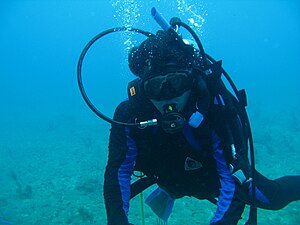 Image via Wikipedia
Image via Wikipedia
Decompression Sickness (DCS) (also known as: The Bends, Diver's Disease, Caisson Disease)are the symptoms which occur after a rapid decrease in pressure, normally caused by an uncontrolled or emergency ascent while diving. Decompression Illness (DCI) is the medical term for which both DCS and lung expansion injury are clumped under, because the medical treatment for both are identical.
During deep or long dives, inert gases (Nitrogen, sometimes Helium) become absorbed into the body's tissues at higher than normal concentrations. As the diver ascends to the surface, these gases leave the solution and form "micro-bubbles" in the bloodstream which can be exhaled safely through the lungs if the ascent is slow enough. If the ascent is uncontrolled or too fast these micro-bubbles can be occur within tissues and organs, which can potential be fatal.
The occurrence of Decompression Sickness is also affected by secondary factors such as; fatigue, dehydration, vigorous exercise (before, during or after the dive), cold, age, illness, injuries, alcohol consumption (before or after dive) and being overweight.
Because DCS stems from bubbles within the bloodstream it is possible that different areas of the body will be affected and therefore the symptoms will be different. It is very important you can identify the symptoms of Decompression Sickness, both for yourself and dive buddies. In all cases, the symptoms of DCS can occur anywhere from 15 minutes to 12 hours post diving.
DCS Type: The Bends
The bends is when bubbles form within the joints, which accounts for approximately 60-70% of all cases of DCS and is referred to as DCS I.
Symptoms of The Bends can include:
* A localized "deep" pain within the limbs of the body (most commonly in the shoulder)
* Pain can be aggravated by active or passive movement of the limb
* The pain may be reduced by bending the limb to a specific position
DCS Type: Neurological
Neurological DCS is when bubbles form within the brain, spinal cord or nervous system, which accounts for approximately 10-15% of all cases of DCS and is referred to as DCS II.
Symptoms of neurological DCS can include:
* Headache (Common)
* Visual disturbances, spots in field of vision, double vision tunnel vision or blurry vision(Common)
* Confusion
* Memory loss
* Unexplainable extreme fatigue or behavior change
* Seizures, dizziness, vertigo or nausea
* Vomiting
* Unconsciousness
* Abnormal sensations such as burning, tingling, stinging around lower chest / back
* Symptoms may work from feet up, bringing weakness in limbs / fatigue
* Abdominal / Chest pain
* Urinary or fecal incontinence
* General muscle weakness and twitching
DCS Type: The Chokes
The Chokes is when bubbles form within the lungs, which accounts for approximately less than 2% of DCS cases.
Symptoms of The Chokes can include:
* A deep burning chest pain under the sternum
* A dry and constant cough
* Shortness of breath
* Pain is worsened by breathing
DCS Type: Skin Bends
The Skin Bends is when bubbles form within the body's upper tissue, which accounts for approximately less than 10-15% of DCS cases.
Symptoms of The Skin Bends can include:
* Itching which most commonly occurs around the ears, face, neck, arms and upper torso
* Sensation of insects crawling on skin
* Mottled or marbled skin around shoulders, upper chest, abdomen with itching
* Swelling of the skin with tiny scar-like skin depressions
All of these symptoms generally come on gradually and persist, though they can be intermittent. Symptoms may occur together or individually. Regardless of the severity of the symptoms, all cases of DCS should be considered serious.
As discussed earlier, lung over expansion injuries and DCS can produce very similar symptoms, even though they are the result of two different actions (holding breath and exceeding ascension rates or safe depth/time). The first aid and treatment for both is identical so there is no need to distinguish between the two. If a diver is suspected to be suffering from Decompression Illness, Responding quickly will greatly reduce the chances of long term injury.
Treatment for divers suffering from DCI:
* End the dive immediately
* If the diver is conscious and responding, lay them on their back and administer oxygen
* If the diver is unresponsive and breathing, lay them left side down, head supported and breathing oxygen
* A diver who is not breathing will require CPR
* Contact local emergency medical care (emergency diver care such as DAN if available)
* Monitor the diver and prevent shock if necessary
While DCS is serious, if treated quickly it is rarely fatal. It is likely dive emergency services will arrange immediate transport to a re-compression chamber, this is normally achieved with specialist low-altitude flights.
Avoiding Decompression Sickness (DCS)
While Decompression Sickness is not fully understood and not an exact science, there are steps you can take to minimise your chances of getting DCS.
* Always make sure you dive well within the limits of your dive table and dive computer
* When you plan your dives, carry out the deepest dives first, then shallower dives
* Make sure your ascent rate never exceeds 18m/60ft per minute
* Always carry out your 5 minute safety stop, even when you are on a no decompression dive
* Dives which require a decompression stop and dives without a 16 hour surface interval give a higher chance of DCS
* Avoid flying 24 hours before or after diving
Above all, plan your dive and dive your plan - safe diving all!
Thanks to
Scuba Site.com for this article
Kathy Dowsett
www.kirkscubagear.com
 Image by Getty Images via @daylife
Image by Getty Images via @daylife






























